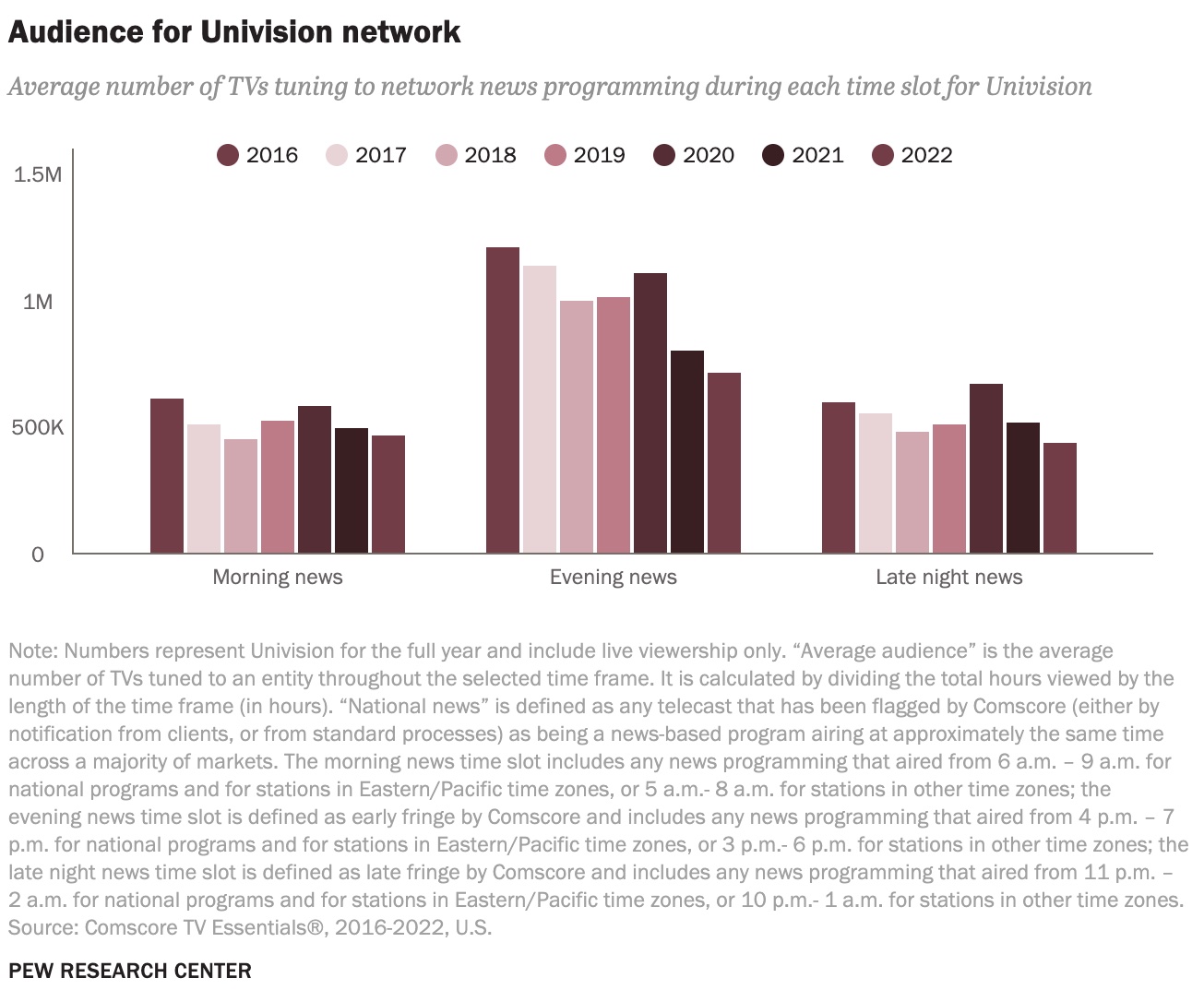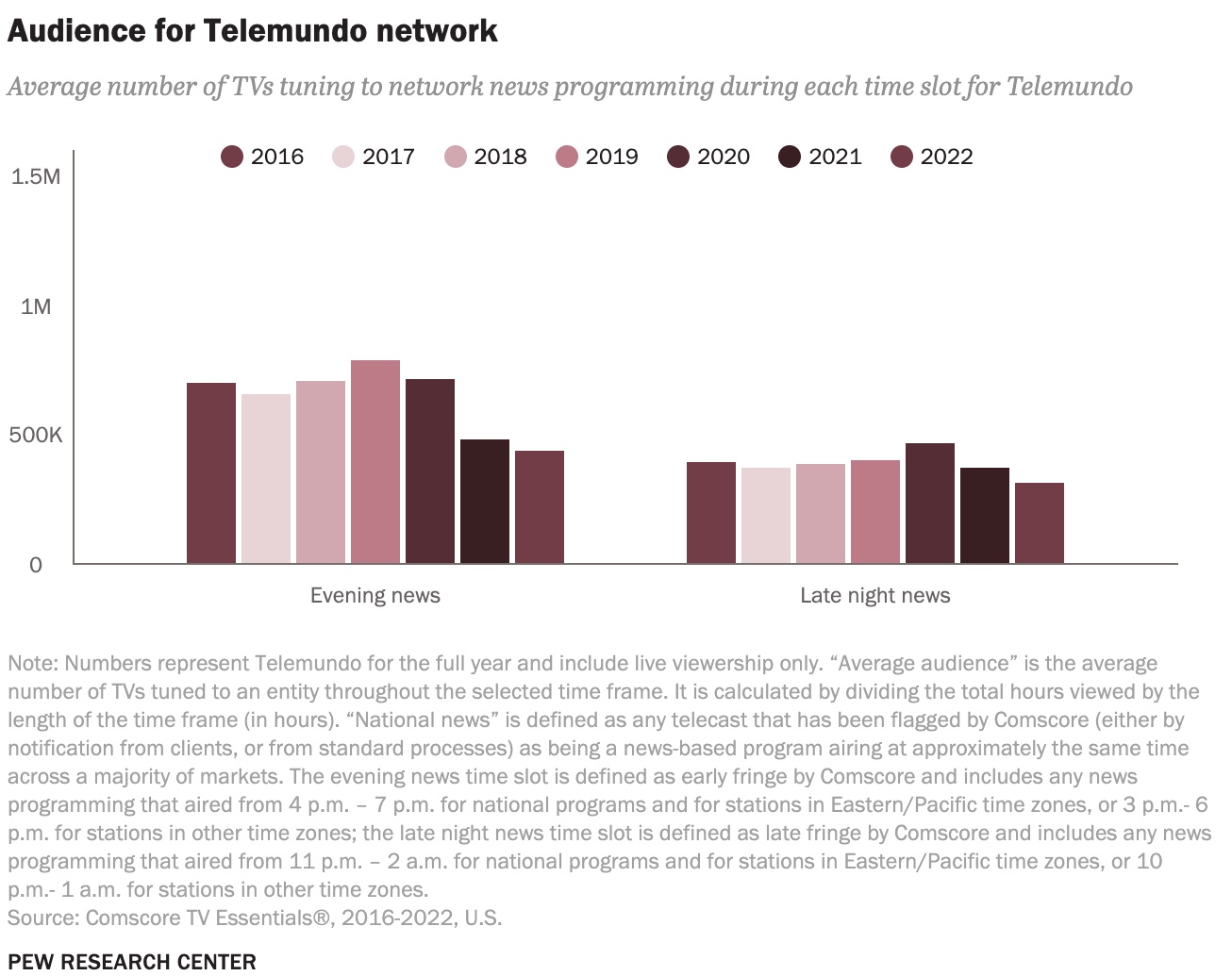

News tailored for U.S. Latinos and Black Americans experienced audience declines in certain traditional formats, according to the Hispanic and Black News Media Fact Sheet, published last month by the Pew Research Center.
Spanish-language networks Telemundo and Univision suffered audience losses in the past few years. Newspaper distribution rates were also negatively impacted. While there is not enough data about Black audiences who watch TV news, the Pew study reported decreased newspaper circulation.
The Black and Hispanic News Media fact sheet is part of a larger project, The State of the News Media report, released by the center biannually since 2004. It includes statistics about the audiences and economics of various media fields, including audio/podcasting, digital news, and public broadcasting.
“We started with the goal of looking at Hispanic-oriented news media, Black-oriented news media, and then tried to find the data that we could find. So, there isn’t a lot of data. There aren’t a lot of television stations that focus on news for Black audiences. But there are newspapers that are focused on Black audiences. And we can get the data for that. So, a lot of it is just looking for what industry data we can find,” Elisa Shearer, Senior Researcher at Pew News and Information Research team, told Latino Rebels.
As the number of traditional U.S. Latino and Black outlets declines, so does data availability. Since 2015, the center has used data from the top 20 U.S. Latino newspapers to calculate an average circulation rate. Then in 2021, there were less than 20 newspapers. Shearer attributed the loss of data to the changing news industry.
Univision and Telemundo are the largest Spanish-language media outlets that dominate news for U.S. Latinos. But for the demographic, television is no longer the preferred source for news. In addition, consuming news in Spanish continues to show a decline, a trend that has been ongoing for years.
In 2022, both Univision and Telemundo had a 16% decrease in viewership for the most watched time slot, the nightly news. The other two news slots are morning and late night. Univision’s evening news audience declined from 804,000 to 714,000, and Telemundo’s evening news viewership declined from 479,000 and 435,000.




U.S. Latinos continue to prefer online media as their main source for getting news over other traditional forms of media. The percentage who go online for news increased from 27% in 2006 to 74% in 2016. In contrast, the overall number of TV news viewers decreased.
“Hispanic media and Black media in the U.S., they’re very similar to what’s happening in the broad media environment in the U.S. There are declines in newspaper circulation and in TV viewership, but Hispanic Americans are one of the groups driving the shift to more digital news consumption. So, it’ll be interesting to see how those change over time,” Shearer said.
Jesenia De Moya Correa, a longtime Caribbean bilingual journalist, is director of the Latino Media Initiative. In 2019, the initiative published a major report, The State of Hispanic News Media.
The biggest share of U.S. Latinos are millennials and younger. They are leading the preference for news in English, according to De Moya Correa. About 91% consume some news in English on a daily basis. Currently, about 80% of U.S. Latinos news outlets offer content in Spanish.
Traditional U.S. Latino media outlets primarily cover news in Spanish for their target audience, first-generation immigrants, a population that is diminishing. News professionals are worried about how the changing demographic will impact the sustainability of the current media landscape.
Meanwhile, traditional Black media outlets cover important topics often ignored by mainstream outlets, such as racism, voting access, and the disproportionate effects of the COVID-19 pandemic on communities of color, more than mainstream media, according to the 2021 report, Why Black Media Matters Now. For example, 23% of articles in Black publications mentioned the topic of racism. In comparison, the coverage level in mainstream media was just at 8%.
The report was published by the Black Media Initiative program at CUNY. The organization supports Black media outlets by offering journalism training and connecting publications to grants. There is a directory of Black-owned media and/or geared towards Black audiences.
Black newspapers overwhelmingly rely on a free distribution model. “What that means is that they print newspapers, they deliver them to different drop spots, like supermarkets, corner stores, churches, etc. And then people can pick them up. So, the circulation increasing means they’re printing more and putting them out in different locations. Across the board for all of community media, the business model for print and print advertising is much better than any digital model that we have.” said Cheryl Thompson-Morton, director of the program.
Two Black-owned newspapers that stayed afloat, despite distribution challenges presented by the pandemic, are the Texas Metro News and the New Citizen’s Press.
The Texas Metro News is a small biweekly local newspaper that uses a free distribution model. Metro News’ print version is free of charge and it is placed at locations such as community centers and schools.
Cheryl Smith, the paper’s owner, was not discouraged by the COVID-19 pandemic. She found a way to keep the publication running despite the difficulty of distributing newspapers during the pandemic. The newspapers were delivered to local businesses, who gave copies to customers, in exchange for free advertising from her.
Smith also owns the Garland Journal and I Messenger. “The Black press is very important. No one else would tell our stories. And so, we had to tell our stories. So now, since others are telling our stories, does that mean we go away? No, we don’t. So, our voices are very important.”
Unlike the Texas News Metro, the New Citizen’s Press circulation rates were deeply impacted by the pandemic. According to founder Rina Rasper, the rate dropped by 50%. Rasper, who identifies as Black and Caribbean, started the small independent newspaper in Lansing, Michigan, 20 years ago. To keep the newspaper running during the pandemic, she created a website for it, and readers can now subscribe to a PDF version. The circulation numbers are slowly climbing back up.
Rasper aims to cover the perspectives and voices of underrepresented communities not covered in mainstream media. The newspaper is free and completely funded by advertisers.
“We’re not trying to talk about things like, breaking news. Sometimes we talk about breaking news, but for the most part, we want to know about people’s lives. And to give, young people support. We just have that responsibility,” Rasper said.
***
Yesica Balderrama is a journalist and writer based in New York City. Her work has appeared on WNYC, NPR, Latino USA, PEN America, Mental Floss, and others. Instagram: @yesica_bald.



[…] Balderrama, Latino Rebels: Audience Declines in Traditional U.S. Latino and Black Media Continue (Sept. […]